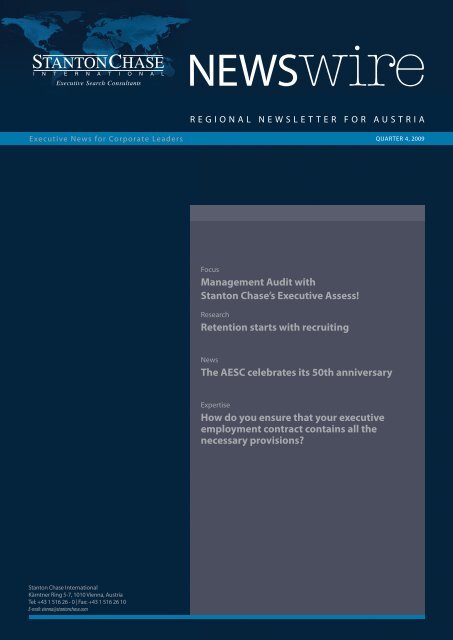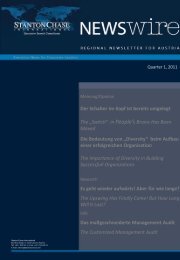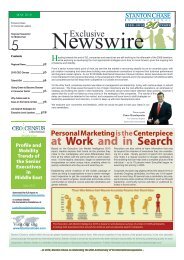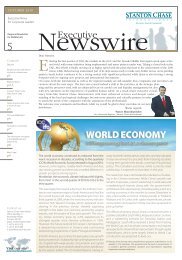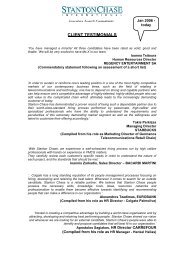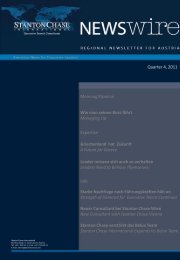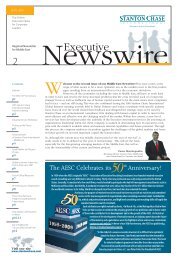Management Audit with Stanton Chase's Executive Assess ...
Management Audit with Stanton Chase's Executive Assess ...
Management Audit with Stanton Chase's Executive Assess ...
Create successful ePaper yourself
Turn your PDF publications into a flip-book with our unique Google optimized e-Paper software.
REGIONAL NEWSLETTER FOR AUSTRIA<br />
<strong>Executive</strong> News for Corporate Leaders QUARTER 4, 2009<br />
<strong>Stanton</strong> Chase International<br />
Kärntner Ring 5-7, 1010 Vienna, Austria<br />
Tel: +43 1 516 26 - 0 | Fax: +43 1 516 26 10<br />
E-mail: vienna@stantonchase.com<br />
Focus<br />
<strong>Management</strong> <strong>Audit</strong> <strong>with</strong><br />
<strong>Stanton</strong> Chase’s <strong>Executive</strong> <strong>Assess</strong>!<br />
Research<br />
Retention starts <strong>with</strong> recruiting<br />
News<br />
The AESC celebrates its 50th anniversary<br />
Expertise<br />
How do you ensure that your executive<br />
employment contract contains all the<br />
necessary provisions?
STANTON CHASE INTERNATIONAL<br />
www.stantonchase.com<br />
ATTACHED TO THE WIRE<br />
p1 Welcome to our latest and updated newsletter from SCI’s Vienna Office<br />
<strong>Stanton</strong> Chase Vienna Office<br />
p2 <strong>Management</strong> <strong>Audit</strong> <strong>with</strong> <strong>Stanton</strong> Chase’s <strong>Executive</strong> <strong>Assess</strong>!<br />
Ask a headhunter: Can you afford a bad hire?<br />
p3 Who to Contact: Partnership<br />
Survey: Sustainability Leadership in Global Corporations<br />
Partner in the Spotlight<br />
p4 Retention starts <strong>with</strong> recruiting<br />
p6 <strong>Stanton</strong> Chase Continues Global Growth<br />
High Five for <strong>Stanton</strong> Chase Stockholm<br />
p7 How do you ensure that your executive employment contract contains all the necessary<br />
provisions?<br />
p8 <strong>Stanton</strong> Chase International strong presence in CEE and SEE<br />
The AESC celebrates its 50th anniversary!<br />
Welcome to our latest and updated newsletter<br />
from SCI’s Vienna Office<br />
Dear clients and friends,<br />
This issue comes at a point in time when the markets<br />
show the first positive signs after a dramatic slowdown.<br />
However, all the economies, including the ones in<br />
Central Eastern Europe, still have to work hard in order<br />
to face and resolve the deep structural problems that<br />
the crisis revealed. Lack of a long term strategic focus<br />
as well as inefficient use of human capital seemed to<br />
be the main issues most companies had to face-and<br />
are still facing.<br />
Based on our long-term executive search experience<br />
in Western, Central and Eastern Europe, we have<br />
developed a precise evaluation tool to carefully<br />
measure a company's senior management talent. By<br />
assessing an organization’s leadership talent we assist<br />
our clients in determining how their executives<br />
compare <strong>with</strong> the market’s available talent and<br />
measure internal capabilities and future potential.<br />
Through this process, the company<br />
<strong>Stanton</strong> Chase Vienna Office<br />
• Based in the centre of Europe, the <strong>Stanton</strong> Chase<br />
Vienna office connects the markets of Western<br />
Europe <strong>with</strong> the emerging Central Eastern and<br />
South Eastern region<br />
• Serves clients in all major industry sectors,<br />
multinational companies as well as strong local<br />
players.<br />
• Five founding partners <strong>with</strong> a solid and proven<br />
track record in <strong>Executive</strong> Search; stable and<br />
professional team<br />
• The local partners' expertise covers not only the<br />
reinforces its position against the challenges of the<br />
markets and bases its future growth on its most<br />
important capital: the human talent.<br />
This state of-the-art management assessment<br />
tool “<strong>Executive</strong> <strong>Assess</strong>!” is highlighted in this issue.<br />
Furthermore we are pleased to introduce selected<br />
insights from our Industry Practice Group leaders,<br />
and provide information about our expertise in<br />
the Central Eastern and South Eastern European<br />
regions.<br />
We hope you will enjoy reading the newsletter and<br />
are available for any questions or queries <strong>with</strong><br />
regards to <strong>Stanton</strong> Chase International. Please do<br />
not hesitate to come back to us <strong>with</strong> your personal<br />
feedback.<br />
Best regards,<br />
The <strong>Stanton</strong> Chase Vienna Partnership<br />
Austrian market but also offers extensive regional<br />
and international experience.<br />
• Over 50 years of collective experience in<br />
<strong>Executive</strong> Search in Austria, unparalleled expertise<br />
in the CEE and SEE Region.<br />
• Services include:<br />
<strong>Executive</strong> Search<br />
Board Services<br />
<strong>Executive</strong> <strong>Assess</strong>ment Services<br />
<strong>Management</strong> Appraisals<br />
1
STANTON CHASE INTERNATIONAL<br />
Gert Herold<br />
Managing Partner<br />
<strong>Stanton</strong> Chase Vienna<br />
g.herold@stantonchase.com<br />
20%<br />
80%<br />
www.stantonchase.com<br />
<strong>Management</strong> <strong>Audit</strong> <strong>with</strong><br />
<strong>Stanton</strong> Chase’s <strong>Executive</strong> <strong>Assess</strong>!<br />
Is the manager ready and capable?<br />
“<strong>Executive</strong> <strong>Assess</strong>!” professionally evaluates the development capabilities of mid and high level managers. It rates<br />
their competence in four areas: Education and experience • Benchmark to the market (availability, salary level) •<br />
Personality, attitudes & objectives • Opportunities to develop<br />
Your benefit<br />
Holistic executive assessment is based on three inputs:<br />
• From the view of the experienced executive search consultant,benchmarked to the market<br />
• From the view of the experienced coach, regarding development potential, attitude and objectives.<br />
• Objectively, through the cutting-edge aptitude testing analytical tools<br />
When <strong>Executive</strong> <strong>Assess</strong>! should be applied?<br />
Whenever a manager faces a significant change in his challenges i.e. mergers and acquisitions,<br />
re-organization, change of corporate culture, increased need of personnel development, organisational<br />
development, strategic build-up of new competences, due diligence, new reporting line.<br />
Building blocks of <strong>Executive</strong> <strong>Assess</strong>!<br />
Module 1 Market Bechmark<br />
(Research)<br />
Development<br />
Module 2 Structured Interview<br />
(SCI Consultant)<br />
Report Selection<br />
Module 3 Structured Interview<br />
(Coach)<br />
Module 4 Psychometric<br />
Succession<br />
Analysis<br />
How <strong>Executive</strong> <strong>Assess</strong>! works<br />
• Briefing on corporate strategy and structure<br />
• Development of competence profile, criteria for evaluation and interview guidelines<br />
• Kick-Off meeting <strong>with</strong> candidates<br />
• Research for market benchmark<br />
• Structured interviews by SCI Consultant and Coach<br />
• Aptitude testing - Psychometric analysis<br />
• Documentation of results (Strengths, weaknesses, competence profile, performance levels etc.)<br />
• Supervisor input to assess full potential<br />
• Recommendation on development activities<br />
• Feedback to candidates<br />
Ask a headhunter: Can you afford a bad hire?<br />
Typical organizational perception of actual costs of a bad executive hire<br />
Direct costs 20%<br />
Equal to 2-3 times executive's annual salary<br />
Indirect costs 80%<br />
Equal to 8-12 times executive's annual salary<br />
Direct costs include:<br />
• <strong>Executive</strong>'s initial recruitment and total compensation<br />
• <strong>Executive</strong>'s extraction from the organization<br />
• <strong>Executive</strong>'s replacement<br />
Indirect costs include:<br />
• Disruption of unit performance and customer relations<br />
• Loss of unit and leadership productivity<br />
• Potential opportunity cost<br />
• Dismissing and replacing lieutenants recruited for departed executive<br />
• Burning of organizational goodwill, plus reduced morale and retention<br />
2
STANTON CHASE INTERNATIONAL<br />
HEIMO HECHT<br />
Managing Partner<br />
h.hecht@stantonchase.com<br />
GERT HEROLD<br />
Managing Partner<br />
g.herold@stantonchase.com<br />
Survey: Sustainability Leadership<br />
in Global Corporations<br />
<strong>Stanton</strong> Chase International<br />
invites you to share your<br />
expertise and insight by<br />
participating in a short<br />
sustainability survey. The goal<br />
of our research is to determine<br />
the preferred skill sets and<br />
core competencies of today’s<br />
Chief Sustainability Officers<br />
“CSOs” and compare these<br />
findings to the skill sets that<br />
CEOs anticipate these<br />
positions will require five years<br />
from now. We will combine<br />
the results of this survey and<br />
follow-up interviews of CEOs<br />
and Chief Sustainability<br />
Officers into a White Paper for<br />
global distribution.<br />
Please take a moment to<br />
complete this brief survey:<br />
TAKE THE SURVEY NOW<br />
www.surveygizmo.com/s/139813/stantonchase<br />
www.stantonchase.com<br />
Who to contact: Partnership<br />
The Vienna team of five partners has over 50 collective years of experience in executive search collected<br />
in leading search firms and has managed over 700 top and middle management level appointments<br />
since 2000.<br />
Client and service dedication and our commitment to personal execution of our mandates on partner<br />
level have generated a solid and sound reputation of quality results and speedy delivery. Our research<br />
consultants and associates are well trained and supported by state of the art technology.<br />
All partners have a clear practice group focus and industry specialisation and understand their client's<br />
needs:<br />
Our motivation for this<br />
research flows from the core<br />
of <strong>Stanton</strong> Chase’s approach<br />
to retained executive search.<br />
The foundation of our<br />
continued success is our<br />
commitment to listening to<br />
our clients, and nowhere has<br />
that commitment been more<br />
visible than in the<br />
sustainability sphere. Whether<br />
hosting experts at our recent<br />
global sustainability<br />
conference or finding a<br />
company’s visionary leader,<br />
we understand that our<br />
success is always rooted in a<br />
deep knowledge of our<br />
clients’ needs.<br />
In addition to completing the<br />
survey, we ask for your active<br />
support and participation in<br />
this research project through<br />
the distribution of the survey<br />
to your sustainability network.<br />
Thank you for your feedback,<br />
and we look forward to sharing<br />
these valuable results <strong>with</strong> you.<br />
ALEXANDER KAIL<br />
Managing Partner<br />
a.kail@stantonchase.com<br />
FRANZ ROIS<br />
Partner<br />
f.rois@stantonchase.com<br />
Partner in the Spotlight<br />
<strong>Stanton</strong> Chase Vienna is<br />
pleased to present Franz Rois,<br />
partner and Head of<br />
Technology Practice<br />
MICHAEL SCHAUMANN<br />
Managing Partner<br />
m.schaumann@stantonchase.com<br />
Franz has 12 years experience in management consulting and<br />
executive-level management in leading international<br />
companies. He is a Partner <strong>with</strong> <strong>Stanton</strong> Chase Vienna and<br />
Head of the fast growing technology practice, serving leading<br />
technology companies in Austria and in the whole EMEA<br />
region.<br />
In his consulting work, Franz concentrates on top-level<br />
assignments in the telecommunications and advanced<br />
technology industries in Europe and the Middle East. He also<br />
provides executive assessment, leadership consulting and<br />
board services. Prior to joining <strong>Stanton</strong> Chase, Franz was a<br />
Partner and Director of a leading international management<br />
consulting company. His consulting experience spans more<br />
than 20 countries in Europe, America and the Middle East.<br />
Before that, Franz was Chief Marketing and Sales Officer and<br />
a member of the <strong>Executive</strong> Board of Tele2 Austria. Previously,<br />
Franz held the position of Vice President for Strategy at T-<br />
Mobile International in London.<br />
Franz holds a Masters Degree in Business Administration<br />
from Vienna University of Economics and Business<br />
Administration and a Masters Degree in International<br />
<strong>Management</strong> (MIM) from CEMS. He is fluent in German,<br />
English and Spanish.<br />
3
STANTON CHASE INTERNATIONAL<br />
By Emerson Hughes<br />
Managing Director<br />
<strong>Stanton</strong> Chase<br />
Montreal<br />
...we researched the<br />
reasons why<br />
employees leave.<br />
We learned that<br />
there are 10 primary<br />
resignation<br />
motivators...<br />
3 are recruiting and<br />
selection related,<br />
and<br />
4 are essentially<br />
disconnects or<br />
failures in<br />
communication.<br />
www.stantonchase.com<br />
Get It Right And Keep It Right:<br />
Retention Starts With Recruiting<br />
Hiring the right employees and retaining key employees are fundamental HR practices. Search firms<br />
that truly partner <strong>with</strong> their clients participate fully in both practices. We have partnered <strong>with</strong> clients<br />
on both fronts for years, long before retention became a hot topic. Now retention is a preoccupation<br />
as the war for talent heats up.<br />
We have always believed that providing a service that supports and enhances retention delivers<br />
additional value to our clients, rendering our core service-recruitment-more cost-effective, and<br />
strengthening our relationship <strong>with</strong> our client at the same time.<br />
Many years ago we researched the reasons why employees leave. We learned that there are 10<br />
primary resignation motivators, and recent research indicates that those motivators are still at play.<br />
We analyzed the motivators and determined that we could directly influence 7 of them; 3 are recruiting<br />
and selection related, and 4 are essentially disconnects or failures in communication. So, we developed<br />
recruiting and communications protocols to address the motivators in an attempt to obviate<br />
resignations. These protocols are embedded in everything we do, starting <strong>with</strong> the first meeting<br />
<strong>with</strong> a client to get job specs. We have found them to be effective, as, sadly, many companies are<br />
resistant to change. They are not doing everything that could be done to retain their employees and,<br />
as a result, they are watching their talent walk out the door.<br />
Let's look at the most common reasons employees leave and what external recruiters can do to<br />
improve the retention of the employees they recruit for their clients.<br />
1. The job or workplace was not as expected. This<br />
can be addressed during the recruiting and<br />
selection process. Recruiters need to present a<br />
clear and accurate description of the job, the<br />
performance expectations, the supervisor's<br />
management style, weaknesses and strengths,<br />
the corporate culture and values. The corporate<br />
company and the candidate going into a new<br />
job should be fully informed.<br />
2. Poor fit. There is a mismatch between the job<br />
and the hire, or the hire and the supervisor. This,<br />
too, can be addressed during the recruiting and<br />
selection process. The assessment process should<br />
be rigorous. Drill down; then, drill down again.<br />
3. There are too few growth and advancement<br />
opportunities. Again, this is an issue that can be<br />
addressed during the recruiting and selection<br />
process. Recruiters should ensure that there will<br />
be enough of a career runway for the candidate's<br />
ambitions. The recruiter should understand the<br />
candidate's career objectives and carefully assess<br />
motivations.<br />
4. Once on the job, there is too little coaching and<br />
feedback, or all too frequently, none at all. This is<br />
a communication and management problem.<br />
External recruiters can facilitate, and sometimes<br />
orchestrate, communications between a manager<br />
and employee. We communicate regularly <strong>with</strong><br />
our hires, and when appropriate, we convene<br />
meetings and include the human resources<br />
department. The key is that we are proactive.<br />
5. The employee feels devalued and unrecognized.<br />
This, too, is a communications and management<br />
problem. Again, we are proactive and facilitate<br />
communication between the manager and<br />
employee. Recognition is one of the most effective<br />
ways to retain and motivate your employees.<br />
A well-designed recognition program can have<br />
a significant impact on employee loyalty and also<br />
influence behaviours, attitudes, values, customer<br />
satisfaction, process improvements, time to<br />
market; quality-the list is potentially endless, and<br />
unique to every company. The point is, people<br />
respond to recognition and appreciation.<br />
6. The employee is stressed from overwork and<br />
a work-life imbalance. This is frequently a<br />
communication problem, and it is usually<br />
solvable. The key is to acknowledge the<br />
conditions and not permit them to persist<br />
<strong>with</strong>out attempting to relieve the pressure, even<br />
temporarily. Without relief, the pressure will build<br />
and lead to a resignation.<br />
7. There is a loss of trust and confidence in senior<br />
leaders. This is frequently a communication<br />
problem. Leaders who don't communicate or<br />
communicate ineffectively are often unaware of<br />
the problem. We encourage our hires to<br />
precipitate communication <strong>with</strong> their manager,<br />
to ask questions, to get informed, to network in<br />
the company and to reach out to the human<br />
resources department.<br />
4
STANTON CHASE INTERNATIONAL<br />
Who is?<br />
Emerson Hughes is<br />
Managing Director of<br />
<strong>Stanton</strong> Chase<br />
International's<br />
Montreal office.<br />
He has been an executive<br />
recruiter for more than<br />
20 years, conducting<br />
numerous searches at<br />
C-level and senior<br />
management levels<br />
across Canada, North<br />
America and Europe for<br />
companies that operate<br />
in virtually every sector.<br />
<strong>Stanton</strong> Chase has 65<br />
offices in 41 countries.<br />
www.stantonchase.com<br />
We are constantly looking for strategies and ideas that we can share <strong>with</strong> our clients to help them retain their<br />
key employees. On a regular basis, we meet <strong>with</strong> our clients and review their retention practices, their successes<br />
and disappointments. We nudge them towards adopting retention best practices. Here are some ideas:<br />
Develop effective corporate employee communications strategies and programs that help employees<br />
understand the business. Share information, open the channels of communication (starting at the top<br />
and let the information cascade down) and explain the company's reward philosophy.<br />
◆ Upgrade your performance-based<br />
compensation systems and stay ahead of the<br />
curve. Gradually move the focus of comp plans<br />
away from base salary toward incentive<br />
compensation.<br />
◆ Provide lateral and cross-functional<br />
assignments or projects.<br />
◆ Poor performance by colleagues can negatively<br />
affect the retention of high potential employees;<br />
therefore, weed out apathetic and 'C' performers.<br />
Poor managers are a liability. Develop, redeploy<br />
or replace them.<br />
◆ Create customized and achievable career and<br />
skills development plans.<br />
◆ Keep employees abreast of their progress and<br />
what they need to do, on a continual basis, to<br />
remain high-potential employees. Provide tools<br />
to help them track performance against<br />
objectives. Amplify the company's long-term<br />
commitment to them.<br />
◆ Provide recognition, formal and informal.<br />
◆ Upgrade your onboarding process. Day 1 can<br />
have a tremendous impact on engagement.<br />
◆ Provide tools that help employees improve<br />
their productivity and effectiveness.<br />
◆ Use knowledge management systems and<br />
tools that facilitate collaboration and networking.<br />
◆ For the right fit, the hiring process should be<br />
rigorous; get it right in the first place.<br />
◆ Job sculpts - Design jobs or assignments that<br />
satisfy employees' interests and use their unique<br />
talents.<br />
◆ Ensure that employees appreciate all the<br />
elements of the company's total rewards package,<br />
both tangible and intangible. Include training<br />
and development programs.<br />
◆ Conduct frequent “'D2stay interviews”'D3.<br />
◆ Develop and upgrade communication skills<br />
in supervisors and managers; when skills are<br />
weak, design programs and tools to facilitate<br />
communications between boss and subordinate.<br />
Frequent communications should be mandatory.<br />
◆ Success in retaining talent should be a<br />
performance expectation for managers, at all<br />
levels of the organization.<br />
◆ Managers and HR should collaboratively ensure<br />
that employees' career needs and objectives are<br />
being met. Ensure employees' careers don't stall.<br />
◆ Provide regular performance evaluations.<br />
Managers should schedule regular meetings <strong>with</strong><br />
subordinates to discuss strengths, weaknesses<br />
and progress toward career goals.<br />
◆ Develop good communication and leadership<br />
skills across the organization. Take frequent<br />
employee satisfaction surveys. Find out what<br />
employees value in a workplace environment.<br />
Broadcast your efforts to act on the findings.<br />
◆ Provide managers <strong>with</strong> performance<br />
management training.<br />
◆ Strengthen internal sourcing and recruiting<br />
processes. Provide recruiters <strong>with</strong> frequent<br />
training. Benchmark your processes against other<br />
organizations.<br />
◆ Ensure that recruiting criteria on job<br />
descriptions are consistent <strong>with</strong> criteria to be<br />
used subsequently in performance reviews.<br />
◆ Extend your succession planning programs.<br />
Include every key position. If the position is<br />
'mission critical', plan for succession.<br />
◆ Provide work-life balance support and options,<br />
such as flexitime, telecommuting or job sharing.<br />
◆ Provide managers <strong>with</strong> interview training.<br />
Hold out for the best fit candidate.<br />
◆ Conduct rigorous reference checks.<br />
◆ Provide a clear statement of how employee<br />
performance is measured. Clearly differentiate<br />
between excellent and average performance.<br />
Describe how performance is measured, assessed,<br />
recognized and rewarded.<br />
The championship is won in the draft, and we<br />
owe it to our clients and to the people we recruit<br />
to get it right the first time. It may seem obvious,<br />
but if rigorous due diligence isn't applied to the<br />
talent acquisition process, then, it can be very<br />
difficult to right the ship. We should do everything<br />
we can to help our clients keep it right. That is<br />
the value we add.<br />
5
STANTON CHASE INTERNATIONAL<br />
www.stantonchase.com<br />
<strong>Stanton</strong> Chase Continues Global Growth<br />
<strong>Stanton</strong> Chase International is expanding its global<br />
presence <strong>with</strong> four new offices in Africa, Europe<br />
and North America. The new offices are located<br />
in Brussels, Sofia, Lagos and Toronto. This growth<br />
reflects the increasing success of <strong>Stanton</strong> <strong>Chase's</strong><br />
partnership-focused approach to executive search<br />
at meeting the needs of clients during these<br />
challenging economic times.<br />
With this expansion, <strong>Stanton</strong> Chase increases its<br />
locations to 68 offices in 41 countries, offering<br />
clients services in Europe, the Middle East, Africa,<br />
Asia Pacific, Latin America and North America.<br />
This growth enhances the professional executive<br />
search capabilities and resources <strong>Stanton</strong> Chase<br />
can access to help its clients <strong>with</strong> their corporate<br />
leadership programs.<br />
The Brussels expansion adds a strong and proven<br />
team in the Benelux region. “With our presence<br />
in Belgium and Luxemburg we close a gap in our<br />
Western European presence and can offer our<br />
clients, executive search services on the highest<br />
level in one of Europe's most important markets”<br />
says Steve Watson, International Chairman of<br />
<strong>Stanton</strong> Chase.<br />
“The Sofia office supports our service capacity in<br />
Central and Eastern Europe and has been raised<br />
to full partner status. This is a reflection of the<br />
professional and successful work of the Sofia team<br />
and the importance of the Bulgarian market in<br />
the CEE” says Watson.<br />
The new Lagos office establishes <strong>Stanton</strong> Chase<br />
as the leader in executive search in Africa, joining<br />
the well-established office in Johannesburg. “By<br />
opening this office we become pioneers in Nigeria<br />
and set the pace of executive search on the African<br />
continent” says Watson. As the only international<br />
executive search specialist in Nigeria, <strong>Stanton</strong><br />
Chase is able to offer clients a unique connection<br />
to an increasingly important market. With 140<br />
million people, Nigeria is the economic hub of<br />
West Africa and key to several industries.<br />
“The new Toronto office expands our presence<br />
into Canada's industrial and financial heartland”<br />
says Watson. <strong>Stanton</strong> Chase has national coverage<br />
in Canada <strong>with</strong> established offices in Montreal<br />
and Calgary. The Toronto office further enhances<br />
<strong>Stanton</strong> <strong>Chase's</strong> significant North American service<br />
coverage.<br />
This growth stems from the alignment of the<br />
<strong>Stanton</strong> Chase approach <strong>with</strong> client needs and<br />
expectations. <strong>Stanton</strong> Chase focuses on listening<br />
to clients, understanding their problems and<br />
challenges and then working closely <strong>with</strong> them<br />
in partnership as an extension of their team.<br />
“With the strength of our global presence, our<br />
partners are able to refer client assignments<br />
between offices in the knowledge and confidence<br />
that client interests will be served professionally,<br />
<strong>with</strong> extremely high quality and reliability” says<br />
Watson. Partners react quickly to client needs and<br />
offer clear unparalleled advice.<br />
“This expansion brings us closer to our clients and<br />
this enhances our ability to deliver a high level of<br />
service, responsiveness and results” says Watson.<br />
High Five for <strong>Stanton</strong> Chase Stockholm<br />
After only three years on the Swedish market, <strong>Stanton</strong> Chase Stockholm is now ranked among the<br />
top five executive search firms in Sweden.<br />
The largest local business magazine, Veckans Affarer, annually publishes a list of the top 10 executive<br />
search firms in Sweden. The survey is conducted among the largest companies that use executive<br />
search services. Several members of the management team receive questionnaires covering topics<br />
such as the level of confidence, client focus, competence and the results of different executive search<br />
firms, as well as the likelihood of hiring them in the near future.<br />
According to this year's survey, <strong>Stanton</strong> Chase Stockholm had made the biggest progress compared<br />
to last year, climbing from the 11th to the 5th position.<br />
6
STANTON CHASE INTERNATIONAL<br />
This depends upon how<br />
successful you are in your<br />
negotiations. This article sets<br />
forth several techniques that can<br />
be employed to obtain the best<br />
deal possible:<br />
www.stantonchase.com<br />
How do you ensure that your executive employment<br />
contract contains all the necessary provisions?<br />
First, you cannot begin your negotiation sessions<br />
until you fully understand what your, and your<br />
potential employer’s, goals are. You should set<br />
down on paper, in order of importance, what you<br />
want out of the new position, both from a<br />
compensation perspective and from a career<br />
standpoint. For example, do you plan to be at the<br />
new company for the long haul or are you using<br />
it merely as a stepping stone to bigger and better<br />
things? If the former, you may want to stress longterm<br />
compensation, such as equity participation<br />
in the employer, as well as current salary and<br />
bonus. Conversely, if you only expect to be <strong>with</strong><br />
the company for a short period of time, then<br />
current compensation (including annual bonus)<br />
may be more important.<br />
At the same time that you are analyzing your goals,<br />
do your best to determine the goals and interests<br />
of the potential employer. In doing so, you may<br />
find that there are situations where imaginative<br />
bargaining could lead to mutually beneficial<br />
solutions. For example, through subtle questioning<br />
you may find that the potential employer currently<br />
is short of cash, but has significant potential for<br />
growth. Thus, you can steer the negotiations to<br />
provide you <strong>with</strong> substantial equity participation,<br />
more than you would have known to ask for had<br />
you not known of the company’s financial<br />
condition and prospects.<br />
Second, you must evaluate your leverage against<br />
that of the potential employer. How badly does<br />
each party want to do the deal? For example, how<br />
much do you need the job? Are you reasonably<br />
secure or insecure in your current position?<br />
Similarly, what is the potential employer’s fall-back<br />
position? Do they have anyone waiting in the<br />
wings who is as qualified as you? How badly do<br />
they need to fill this position and how quickly<br />
must this be done? Deriving answers to all of these<br />
questions will give you a fair idea of the relative<br />
leverage between the parties and, accordingly,<br />
will tell you how “tough” you can be in your<br />
negotiations.<br />
Third, when you make your compensation desires<br />
known to the other side, you must be able to<br />
thread the needle between selling yourself short<br />
on the one hand and making exorbitant demands<br />
on the other, which could cast a pall over, if not<br />
outright kill, ongoing negotiations. To do this<br />
effectively, you must do your homework. What<br />
are your comparables (i.e., what are your<br />
colleagues in similar positions in similarly sized<br />
companies earning in terms of salary, incentives<br />
and benefits, etc.)? This information can be derived<br />
through careful research, often using<br />
compensation tools found on the internet, by<br />
hiring a compensation expert or by relying on<br />
experienced counsel.<br />
Fourth, and most important, is the strategy you<br />
employ in the actual negotiation process. You do<br />
not want to appear too eager by making quick<br />
offers and concessions. Although it sometimes<br />
can be useful to make the first offer (as it would<br />
be setting expectations on your playing field) in<br />
most cases dealing <strong>with</strong> employment contracts it<br />
is the potential employer who makes the first<br />
move, at least <strong>with</strong> respect to salary issues. This<br />
would allow you to “bracket” your eventual<br />
compensation through your counter offer. For<br />
example, if at some point you are offered “x” per<br />
year in salary, and you would like to settle<br />
somewhere in the “y” range (assuming that this<br />
desire is backed up by useful comparables), you<br />
would then counter in the “z” range, <strong>with</strong> the<br />
expectations that you and the other party would<br />
meet somewhere in the middle, your classic “split<br />
the difference” approach which often will work in<br />
end-stage negotiations. However, it is very<br />
important that you not make any concessions to<br />
quickly. Early concessions are usually larger than<br />
those made at the end of the negotiation process.<br />
Regardless of whether you are experienced in the<br />
negotiation techniques described above, it is very<br />
important that you consider utilizing an attorney<br />
to handle the process for you. First, use of an<br />
experienced attorney will give you a degree of<br />
credibility in your negotiations that you otherwise<br />
may not have. Second, the attorney can be your<br />
“bad cop,” making demands on your behalf while<br />
you stay above the fray and whom you can<br />
disavow if negotiations take a turn for the worse.<br />
Third, your attorney will have knowledge of many<br />
important legal issues of which you simply may<br />
not be aware. Lastly, as mentioned above, your<br />
attorney (again, if experienced) will be aware of<br />
the standards of the industry, which will prevent<br />
you from making unreasonable demands on one<br />
hand and from underselling yourself on the other.<br />
Published on: https://www.bluesteps.com/newsletter/Contract-Negotiation.aspx<br />
Author: Robert M. Fields represents executives on a national and international basis and can be reached at his New York<br />
City office at (212) 672-1672 or his Westchester County, New York office at (914) 763-3788. You can also contact him by<br />
e-mail at rmfields@rmfieldslaw.com<br />
7
STANTON CHASE INTERNATIONAL<br />
<strong>Stanton</strong> Chase International strong presence<br />
in CEE and SEE<br />
Over the years <strong>Stanton</strong> Chase International´s<br />
Vienna office has become one of the key<br />
players in executive search in Austria as well<br />
as Central and South Eastern Europe.<br />
Based in Vienna, considered to be “the heart<br />
of Europe”, our partnership has developed a<br />
unique profile in the region since the fall of<br />
the “Iron Curtain”. In close co-operation <strong>with</strong><br />
the local offices in the neighbouring CEE and<br />
SEE countries we successfully accompanied<br />
our clients in their effort to build their local<br />
management structure in the emerging part<br />
of Europe. Being pioneers in the recruitment<br />
of executives in the Central European region<br />
we offer unparalleled experience in handling<br />
difficult search mandates on a national and<br />
international level. Presence in local markets<br />
and profound insider understanding of their<br />
conditions are prerequisites for competent<br />
consulting services.<br />
The AESC celebrates its 50 th anniversary<br />
In 1959 when the AESC (originally "AERC"<br />
Association of <strong>Executive</strong> Recruiting Consultants)<br />
was founded retained executive search consulting<br />
was very different to what it is today. Firstly, this<br />
new profession was really only practiced in the<br />
United States. Secondly, it consisted of a few small<br />
firms, mostly headed by principals who had left<br />
management consultancies such as McKinsey<br />
and Booz Allen. And thirdly, it produced revenues<br />
that were only a tiny fraction of the $11 billion<br />
that we estimate the worldwide revenues to be<br />
today. Much has changed since then, but much<br />
has also remained the same.<br />
As always, the purpose of retained executive<br />
search has been to provide an exclusive and<br />
committed service to the top management of<br />
organizations when recruiting executive talent.<br />
Confidentiality, ethical and professional practices,<br />
and high level consulting and recruiting skills still<br />
typify the seasoned executive search consultant.<br />
Such attributes are rightly valued by clients. On<br />
<strong>Stanton</strong> Chase International<br />
Kärntner Ring 5-7, 1010 Vienna, Austria<br />
Tel: +43 1 516 26 -0 | Fax: +43 1 516 26 10<br />
E-mail: vienna@stantonchase.com<br />
STANTON CHASE INTERNATIONAL<br />
CEE AND SEE OFFICES<br />
Vienna (Bratislava, Budapest) • Prague • Warsaw • Moscow<br />
Bucharest • Ljubljana • Sofia • Belgrade • Athens • Istanbul<br />
March 5th, at the Metropolitan Club in New York,<br />
we had occasion to celebrate the amazing growth<br />
of our profession and to honour some of those<br />
who contributed to its development and to the<br />
growth of the AESC. An historical overview of the<br />
development of executive search, an industry<br />
panel about the future of the industry and a gala<br />
dinner were the highlights of our anniversary<br />
celebrations capture on our website. In honour<br />
of our 50th Anniversary, the AESC has published<br />
“A history of retained executive search”.<br />
“In the midst of a severe economic downturn it<br />
is difficult to be optimistic about the future.<br />
However, I am firmly convinced that the demand<br />
for executive talent will return and sooner than<br />
some think. The need for talented leaders is<br />
greater at times like these than at any other. The<br />
executive search profession will not only serve<br />
that need but continue to prosper as it does so”<br />
says Peter Felix, the President of AESC.


